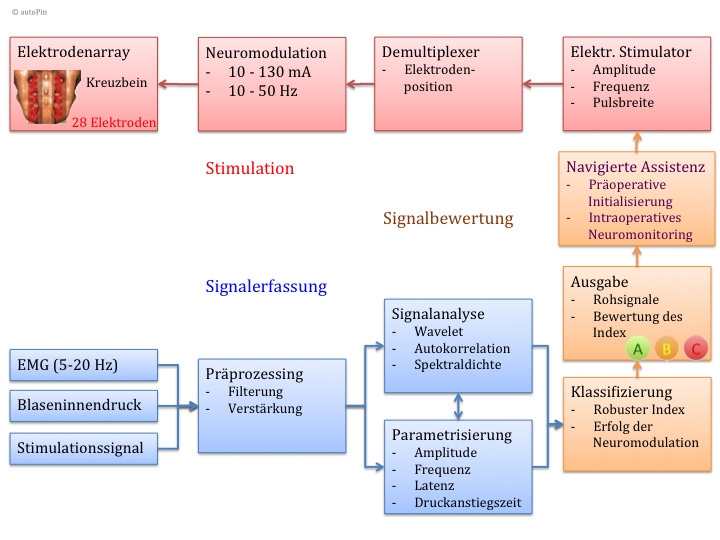Protecting nerve tissue during bowel surgery
After bowel surgery, more than half of the patients suffer from irreparable nerve damage. Now scientists have developed an assistance system that warns surgeons about the risk of inflicting possible injury during operations in the pelvic area. The experts are currently working on a solution for minimally invasive surgery.

According to the German Federal Statistical Office, bowel surgery is one of the most common surgeries in Germany. Complications are frequent, however, with more than half of the patients struggling with incontinence or sexual dysfunction following intervention in the pelvic area due to nerve tissue damage. The nerves controlling bladder, anus and sexual functions surround the intestine in a wafer-thin web. “In terms of color and structure, it’s very difficult to distinguish this nerve network from other tissue and smaller blood vessels, which frequently leads to injury,” explains Prof. Klaus-Peter Hoffmann from the Fraunhofer Institute for Biomedical Engineering IBMT in St. Ingbert. What makes it all the trickier is that often the surgeon doesn’t notice the injury during the surgery, and problems only become evident a few weeks after the operation.
Warning surgeons before they inflict nerve damage
In the IKONA project (Continuous intraoperative neuromonitoring as a microtechnological navigation instrument), Fraunhofer IBMT coordinated a joint effort with several partners to develop an assistance system for intraoperative neuromonitoring. This involves placing flexible, wafer-thin electrodes directly onto nerve fibers and stimulating them by means of electric impulses. Software from IBMT partner inomed evaluates whether the surgical intervention is affecting the autonomous nerve network: if the surgeon gets too close to a nerve, or pushes or distends it, nerve function is affected. The surgeon is given a visual and acoustic warning if there is a danger of injury. The system is already undergoing clinical testing.
Currently, Hoffmann and his team are working on the successor project, autoPIN
(Assistance system for the stimulation of autonomous pelvic nerves with the aim of intraoperative neuromonitoring in laparoscopy). In the autoPIN project, the Fraunhofer researchers are working with partners to facilitate this sort of neuromonitoring during operations, even for minimally invasive surgery. This differs from standard surgery in that electrodes have to be placed on the body externally. The problem is that the sacrum lies between the electrodes and the nerve network – and that obstructs the electrical field. “The challenge is placing the electrodes so that they are still able to stimulate the nerve network,” explains Hoffmann. To achieve this, scientists from the Department of General, Visceral and Transplantation Surgery at Mainz University attach an electrode array to the body to form a grid-like field. “Then we activate individual electrodes, allowing us to identify those that will permit us to optimize the geometry of the electric field in such a way that we can effect a neuromodulation,” says Hoffmann, describing Fraunhofer IBMT’s role. Partner inomed has developed a smart algorithm that evaluates the raw signals from the neuromodulation and processes them in such a way that the surgeon can tell at a glance whether there’s any risk of injury. “Our aim is to assure that surgery on the pelvic organs is of a guaranteed quality and protects the nerves. It’s all about preserving quality of post-op life,” says the senior doctor on the team, Prof. Dr. Werner Kneist.
Since surgery in the pelvic area can often last several hours, the assistance system draws on the dry silicone electrodes developed at Fraunhofer IBMT in the course of the IKONA project, with nanoparticles within the silicone guaranteeing the necessary conductivity. In contrast to conventional electrodes, these silicone electrodes can provide a stable and reliable interface over an extended period of time. The new assistance system for minimally invasive surgery is currently undergoing preclinical trials.